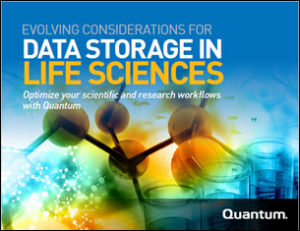
The latest lab instruments are driving the need for powerful IT resources in the life sciences, including data storage.
Laboratory technologies are evolving rapidly. The latest instruments for life science research enable scientists to visualize highly detailed 3D models of protein molecules and assemble genomes in a fraction of the time they could in the past.
New lab instruments are also producing tremendous amounts of data. For example, in the field of genomic research, nextgeneration sequencing (NGS) instruments can output 1 TB of data per hour.
Cryo-electron microscopy (cryo-EM) is another burgeoning field that can produce massive data volumes. With cryo-EM, researchers study protein molecules at cryogenic temperatures, taking numerous images of each molecule and constructing 3D models. Researchers then use those models to study cancer at a molecular level and develop strategies for combating emerging viruses, such as Zika. The cryo-EM workflow can generate 5 TB of data in 24 hours.
Life science teams often require substantial high-performance computing (HPC) resources to process and analyze data created by new instruments and techniques.
Now, many organizations need to bolster their storage environment.
Download the new report from Quantum, to discover the latest in data storage for the life sciences.
All information that you supply is protected by our privacy policy. By submitting your information you agree to our Terms of Use.
* All fields required.




